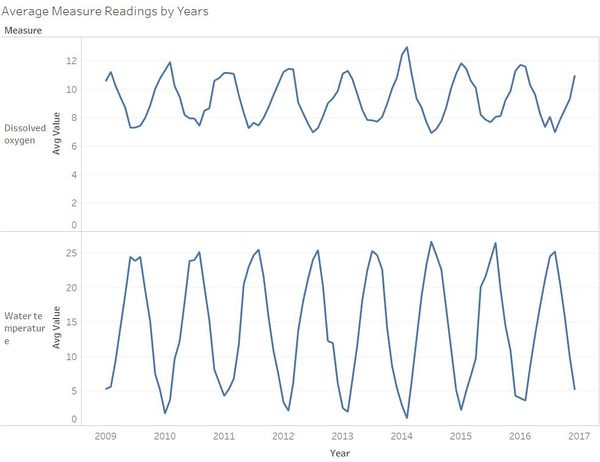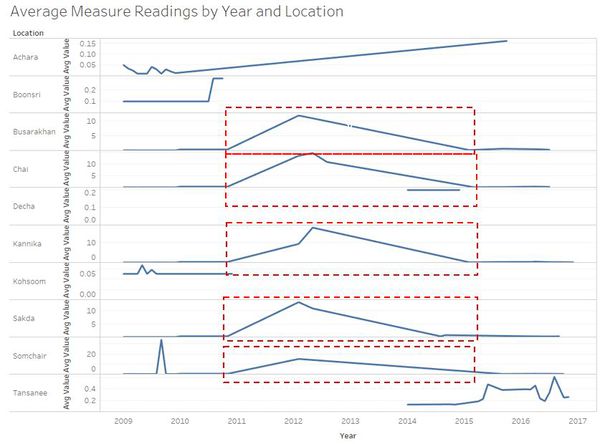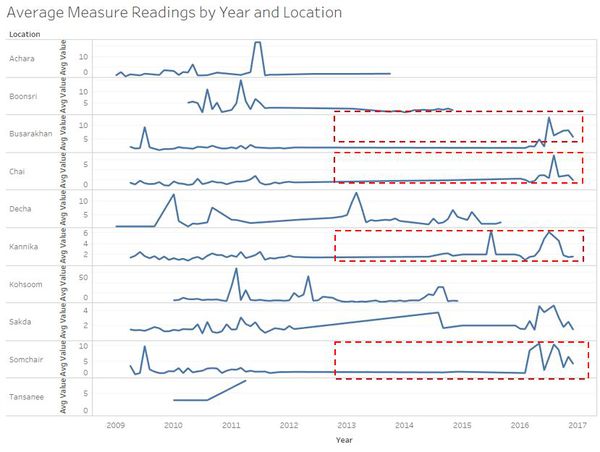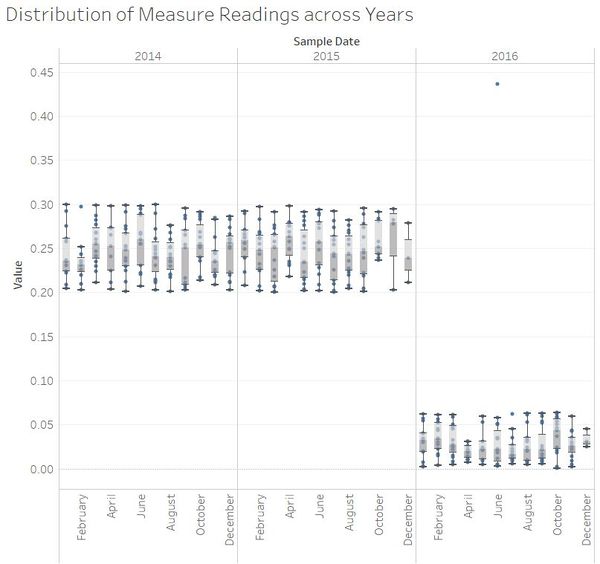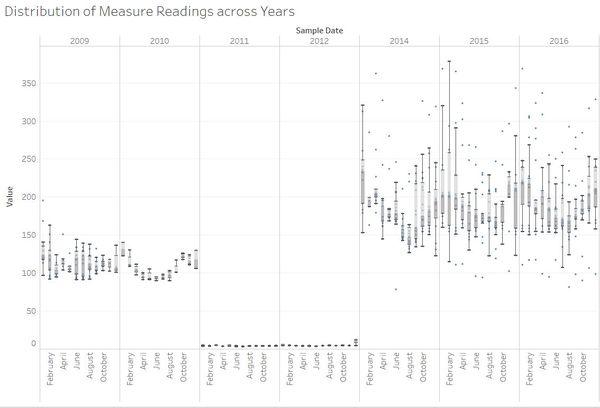ISSS608 2017-18 T3 Assign Kalai Selvi Methodology and Dashboard Design
Question 1: Characterize the past and most recent situation with respect to chemical contamination in the Boonsong Lekagul waterways. Do you see any trends of possible interest in this investigation?
Cyclic Trend in Average Monthly Dissolved Oxygen and Water Temperature Readings observed across the years
Average monthly dissolved oxygen levels in the waterways consistently declines from January to July/August each year and increasing trend is observed from August to December for each year. On the other hand, increasing trends in monthly average water temperature readings is observed from January to August and decreasing trend is observed from August to December for each year.
Consistent Patterns for Petroleum Hydrocarbons Readings across locations
There was increasing trend in the average monthly Petroleum hydrocarbons readings from November 2010 to around February 2012 for Busarakhan, Somchair and Tansanee and an upwards trend from November 2010 to May 2012 for Chai and Kannika locations. After the upward spike in 2012, a decreasing trend was seen in the average monthly Petroleum hydrocarbons readings for all 5 locations around the same period.
Consistent Patterns for Nickel Readings across locations
Since 2011, the average monthly Nickel measure readings follows the same pattern for Busarakhan, Chai, Kannika, Sakda and Somchair locations and there was an sharp spike in the average monthly Nickel readings in the first half of 2016.
Decreasing Trends in Chlorodinine Readings
The Chlorodinine levels has been consistent for 2014 and 2015. The Chlorodinine readings recorded in 2016 are much lower compared to 2014 and 2015 readings. The range of Chlorodinine values were wider in 2014 and 2015 as seen from the inter quartile range (IQR) of the boxplots in 2014 and 2015.
Increasing Trends in Total Hardness levels
Total hardness levels have been generally declining from 2009 to 2010, and the value of the readings are closer in range in 2010 as seen with the smaller IQR. The total hardness levels were lowest in 2011 and 2012. Increasing trends in the total hardness levels were observed for 2014 to 2016 and the first quartile (25th percentile) is also at a higher value in 2014 to 2016 compared to previous years. There were more highly skewed total hardness readings in 2014 to 2016.
Question 2: What anomalies do you find in the waterway samples dataset? How do these affect your analysis of potential problems to the environment? Is the Hydrology Department collecting sufficient data to understand the comprehensive situation across the Preserve? What changes would you propose to make in the sampling approach to best understand the situation?
Inconsistent Number of Measure Records
The number of records for each locations is not consistent. Some years have higher number of records compared to others. In Boonsri, Busarak, Chai, Kannika, Kohsoom, Sakda and Somchair, the highest number of measurements were recorded in 2015 to 2017. Chemical measures were only recorded from 2009 for Achara, Decha and Tasanee locations. In comparison to previous years, the samples collected have reduced in recent years.
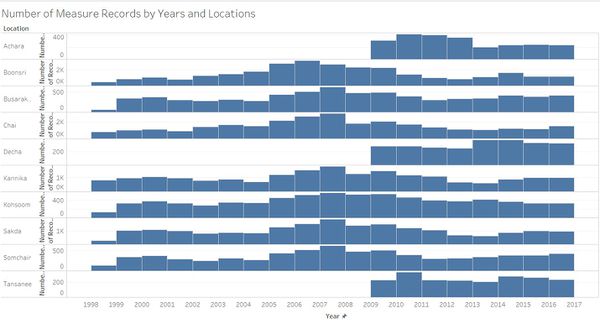
Spike in Methylosmoline levels in Somchair and Kohsoom
While the average Methylosmoline monthly readings are gradually decreasing from 2015, there is a sudden steep spike in the average Methylosmoline monthly reading in Somchair to a average value of 130.5 in January 2016 from 4.5 in October 2015. Also, the average monthly Methylosmoline has remain constant throughout 2016. Even drilling at the day level readings, the daily Methylosmoline level has remained stagnant throughout 2016. This could be due to a sudden bust of Methylosmoline chemical around Somchair region. In Aug 2016, a sudden spike in average Methylosmoline level was also observed in Kohsoom.
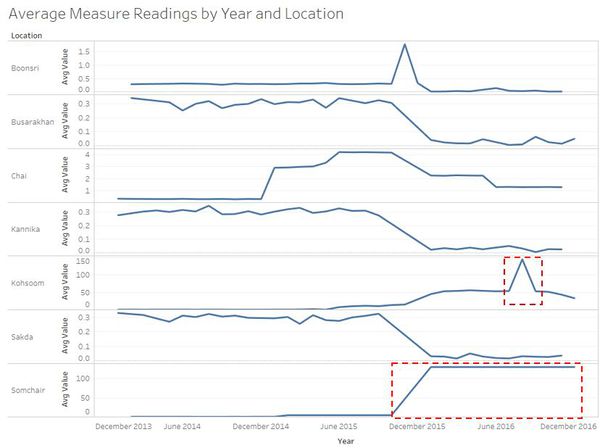
Spike in Water Temparature readings in Chai
The number of water temperature readings taken at Chai has been consistent since 1998 till end of 2015. A sharp increase in the number of water temperature readings can be seen from the line chart below in Chai for 2016. The number of temperature readings taken at other locations are more regular. Drilling down by number of records, we can see that the highest number of temperature readings were c
600 px
Trends in Biochemical and Chemical oxygen Demand (Cr) levels
The trend in the biochemical levels has been consistent across the years, however there are sudden spikes in Mar 2015 and February 2016 in Tansanee location and these spikes are also observed for the Chemical oxygen Demand (Cr) chemical. The 2 spikes specifically occurred on the same day for both these chemicals (20 March 2015 and 17 February 2016).
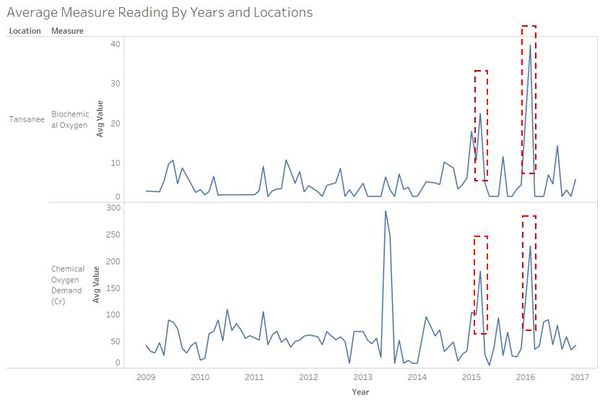
Spike in Iron Levels across Locations
For Iron chemical readings, the values recorded are very low and almost constant across the years for all locations. However, a unusual spike is recorded in August 2003. If we drill further at day level, this spike has occurred on 15 August 2003 in Busarakhan, Chai, Decha, Kanika, Kohsoom, Sakda ad Somchair locations.
600 px

